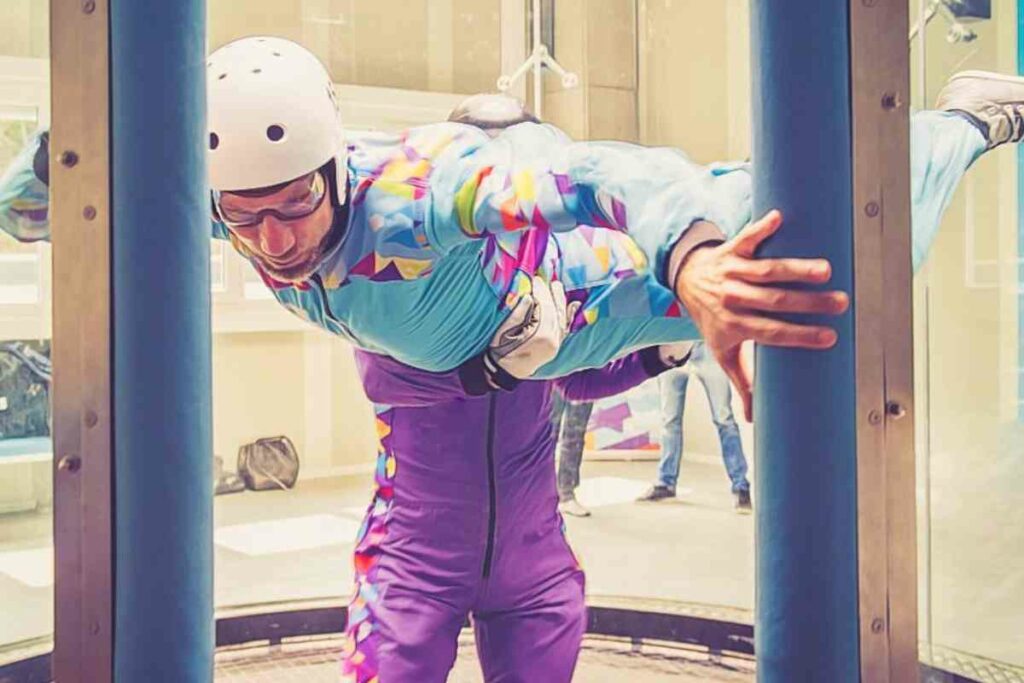If you’re thinking of investing in your own wind tunnel for indoor skydiving, you’re sure to wonder, how much does an indoor skydiving machine cost?
After all, there’s a lot involved, from parts to construction. The initial investment in the equipment itself is roughly $500,000.
The construction is what will really cost you, unfortunately. This reaches up to $15-30 million, depending on the type of tunnel!

Of course (because they rent it out) some consider the wind tunnel to be quite lucrative when all is said and done. Regardless, there are some vital things you’ll want to consider!
How Much Does an Indoor Skydiving Machine Cost?
So, an indoor skydiving machine costs about 500,000.
This is quite the sum. Is it worth it, or is renting better? Well, renting a wind tunnel costs about 2,000-3,000 per hour. You can also go to an indoor skydiving center for around $60-100 an hour.
Read before you go – Can You Indoor Skydive If You Have a Medical Condition?
If you have your own wind tunnel, however, you can always rent it out yourself, potentially making up the initial investment plus some.
Of course, if you’re planning on building a wind tunnel, there are some key steps and points you’ll need to keep in mind!
Building a Wind Tunnel
If you’re thinking of having a wind tunnel built, there are a few things you’ll need to decide.
Here are the most important things to know before you get started:
- First off, you’ll need to decide the size of the tunnel. The bigger the tunnel, the more fliers that can skydive at once. Of course, the cost will also be accordingly higher. Most settle on around 14 feet in diameter. This is big enough to support a few skydivers at once, and to meet the majority of your skydiving needs. If the tunnel were much smaller than 14 feet, you’d only be able to have one person skydive at once. If it were much bigger than this, the cost might exceed your budget. So, folk generally agree that 14 feet in diameter is ideal!
- Next, we’ve got the speed of the tunnel. 170 miles per hour is the typical speed of commercial indoor skydiving centers. This provides enough wind pressure to support to classic belly-up skydiving position. It’s strong enough to support most maneuvers, although it is true that higher speeds create even more possibility. This being said, stronger winds also create more risk. Tunnels with higher speeds are ideal for more expert skydivers, but perhaps not beginners. Since most indoor skydivers are beginners, we could conclude that, for most, 170 MPH is indeed ideal!
- One of the first steps in building an indoor wind tunnel is to choose to type of tunnel. There are a couple of kinds: portable tunnels, and permanent installations. Portable tunnels are the most affordable, whereas permanent tunnels are more complicated to install and therefore more costly. There are a few differences between portable and permanent installations that you’ll want to be aware of!
Portable Tunnel
Portable tunnels, as their name implies, are portable wind tunnels. They’re not permanently affixed. There are a couple of other differences.
For one, portable wind tunnels are noisier than their permanent installation counterparts. This reduces your options when it comes to places to use the tunnel.
Otherwise, you could end up disturbing the area or your neighborhood. Some will use portable tunnels on boats because they can go away from areas with a lot of people, and they’ve got a great view of the water!
Next, portable tunnels tend to be smaller. This reduces the number of folks you can have indoor skydiving at once but also shrinks the cost accordingly.
Of course, you can still have a few people in a portable tunnel at the same time, it just depends on the size of the tunnel. Lastly, portable tunnels sometimes, to work optimally, depend on fair weather!
Looking to expand your knowledge about indoor skydiving? Embark on a captivating journey into the realm of indoor skydiving with our in-depth beginners’ guide, tailored to acquaint you with this thrilling experience.
Permanant Installation Tunnel
A permanent installation tunnel requires serious construction, with enormous holes being dug out for the return air, and use chillers, which can be pricey.
Permanent installation tunnels can also be built much bigger, however, and they will work in any weather!
Final Words
As you can see, there’s a lot involved in creating your own wind tunnel, most especially money (starting at $500,000 just for equipment).
Truly, it’s a huge endeavor, and many opt to simply rent the tunnel by the minute or by the hour instead.
If you do choose to build your own wind tunnel, don’t forget everything you have to consider, including speed, size, type, and all – and best of luck!







